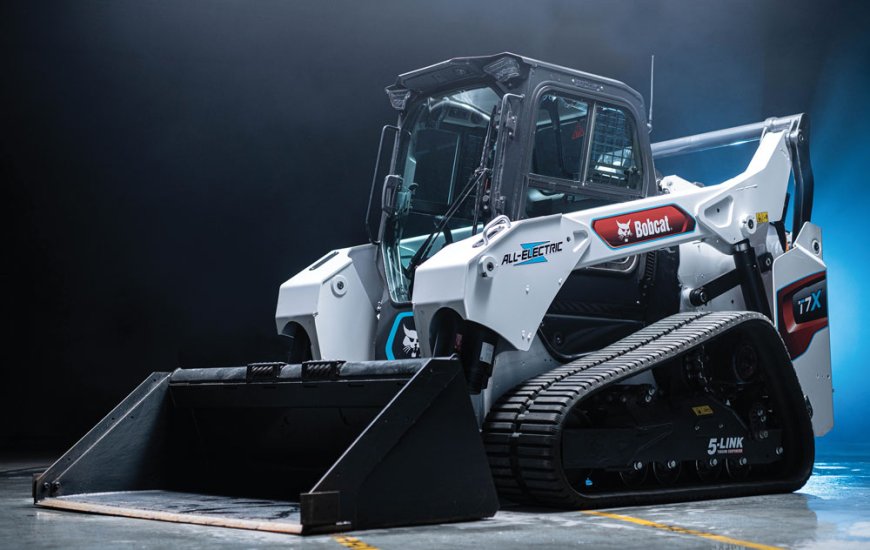Developments in ZERO EMISSION CONSTRUCTION EQUIPMENT
Government zero-emission goals around the world have manufacturers of off-road vehicles thinking about moving to all-electric models. One step toward that future is focusing on construction vehicles’ powertrain. By creating an electric powertrain, there’s an opportunity to make higher efficiency transmissions, too. Moving from a diesel-powered machine, which also employs hydraulically actuated motion controls, to an all-electric or partially electric machine requires manufacturers to completely reconfigure their vehicles.

Government zero-emission goals around the world have manufacturers of off-road vehicles thinking about moving to all-electric models. One step toward that future is focusing on construction vehicles’ powertrain. By creating an electric powertrain, there’s an opportunity to make higher efficiency transmissions, too. Moving from a diesel-powered machine, which also employs hydraulically actuated motion controls, to an all-electric or partially electric machine requires manufacturers to completely reconfigure their vehicles. Essentially, this switch mirrors how the aviation industry created the concept of fly by wire. Modern aircraft use electrically controlled actuators to move a planes’ flaps to create lift. Similarly, construction vehicles will move to a drive-by-wire model. The benefits of all-electric, or electro-mechanical, actuation include being easier for a vehicle operator to control and (with the addition of sensors) making performance data from the vehicle’s actuators and powertrain available to fleet managers and vehicle drivers.
Launching a business venture to electrify construction
To satisfy the construction industry’s need for zero-emission and electric vehicles, Moog Inc. launched a new venture this year called Moog Construction, which aims to accelerate the electrification and automation in construction by enabling the world’s safest, most sustainable, and productive machines. As part of this new venture, Moog Construction’s engineers offer three things.
First, expertise in motion control, automation, simulation, modeling, and innovation for whole systems and across markets ranging from aerospace to renewable energy. Today, most centralized systems on a construction vehicle have one motor and pump distributing hydraulic fluid; the pump is always running. With a traditional loader, the machine would waste energy on every axis for lifting, tilting, moving—even when the machine is stationary. Moog has designed a more efficient system using distributed control to send power only when and where a construction vehicle needs it, such as lifting dirt or moving side to side, so the off-road vehicles Moog designs waste little to no energy.
Second, efficiently managing motion and thermodynamics for a vehicle, which keeps each component operating at the right temperature range, reduces energy use, and extends run time.
Third, intelligent software that optimizes a construction vehicle’s motion as it carries out tasks by learning to smooth out the machine’s movements and operation, which boosts run time by more than 25 percent. By smoothing out the peak moments of energy usage, the machine gets the same output and work done with less energy.
Offering an array of products for construction vehicle makers
Moog Construction not only offers a full range of products that include electric actuators and electrohydrostatic actuators, or EHA, but a complete platform of integrated products for an electric vehicle, including motor, drive, and vehicle controller. Moog’s EVCM, or Electric Vehicle Control Module, is central to the vehicle design. In fact, adding a fully connected controller can move data between the machine and operator as well as between the machine and fleet manager in real time. Being able to move data between a machine, its owner, and operator enables a series of new functionality for improving the human-machine interface. Easily transferring data in this way makes the machine adaptive to the operator’s needs and style of work. Having functions that allow manufacturers to customize the operator’s experience to best suit his or her needs also creates a new business model for the vehicle maker; manufacturers can collect data about how their vehicles are used in the field and extend the life of each vehicle model with over-the-air (OTA) feature updates like the ones Tesla offers its customers. By giving off-road vehicle operators more ways to control their machine, the operator can perform some tasks automatically, such as digging a trench at a certain degree of pitch. These improvements could be a first step toward remote control or even autonomous construction vehicles.
Electrification at work
Some examples of applications in which Moog Construction has deployed the solutions mentioned above include converting a 4.5-ton capacity wheel loader and a track loader with a 2.5-ton bucket capacity to fully electric models (i.e., electric powertrain and electric actuators for handling and steering). The track loader is all-electric, meaning there are no hydraulic parts, no oil, fewer parts than a diesel-electric machine, zero-emission, and quiet enough that construction crews can communicate with one another without shouting or hand signals. The Moog energy management software onboard the track loader also gives the machine more battery life because the machine supplies energy only to the parts of the machine when needed and in the amount needed. This significantly extends battery life and makes zero-emission construction machines possible because they can do more work for a longer time before needing a charge.
The initial, all-electric solution for the track loader was thought to be too robust versus its hydraulic predecessor, but the intelligence of the machine systems allows for different work modes to control the output when needed. There’s a misconception across many industries, not just construction, that hydraulic systems are stronger than electric ones. It takes the right experience to best apply the advantages of these different technologies to a machine. For example, there is a long history of converting industries from hydraulic to electric; Moog successfully moved its customers from hydraulic-only motion systems for flight simulation to all-electric actuation, which is the industry standard today. That said, it’s important to collaborate with customers to determine the best, technology solution for their machines. That solution could be all-electric or EHA
Hits: 2








